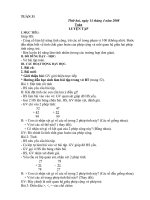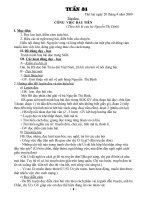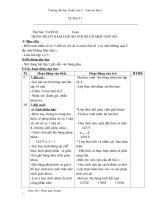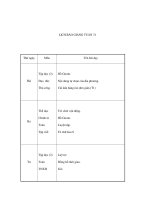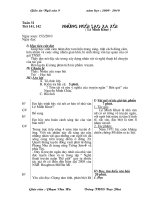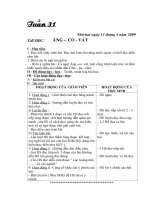- Trang chủ >>
- Khoa học tự nhiên >>
- Vật lý
Giáo án tuần 31 – Tiếng anh 4
Bạn đang xem bản rút gọn của tài liệu. Xem và tải ngay bản đầy đủ của tài liệu tại đây (182.27 KB, 12 trang )
<span class='text_page_counter'>(1)</span><div class='page_container' data-page=1>
<b>WEEK 31- Period: 121</b>
<i>Date of planning: 08/04</i>
<i>Date of teaching: 4a1, 4a2(10/04); 4a3, 4a4(11/04); 4a5(12/04)</i>
<b>UNIT 18: WHAT'S YOUR PHONE NUMBER?</b>
<b>Lesson 3(1,2,3)</b>
<b>I. Objectives:</b>
By the end of the lesson, pupils will be able to pronounce two-syllable words with
the stress on the second syllable: <i>re’peat, en’joy, in’vite </i>and <i>com’plete</i>.
<b>II. Language Focus: </b>Spoken interaction, phonics.
+ re'peat Can you re'peat that?
+ en'joy She en'joys the party.sers.
+ in'vite They in'vite me to go for a picnic.
+ com'plete We have to com'plete the sentences.
<b>III. Resources: </b>Ss’ book, recording, computer, stereo, (projector), poster, word cards
(with word stress) ...
<b>IV. Procedure:</b>
<b>Teacher’s work</b> <b>Students’</b>
<b>activities</b>
<b>Warm-up: </b>
- Spend a few minutes revising the previous lesson. Have
pupils play the game <i>Say the phone numbers </i>again<i>.</i> <sub>Whole </sub>
class
<b>1.</b> <b>Listen and repeat.</b>
Tell pupils that they are going to practice pronouncing the
following words: <i>re’peat, en’joy, in’vite </i>and <i>com’plete.</i>
First, put the words re’peat, <i>en’joy, in’vite </i>and <i>com’plete </i>on the
board, with the stress marks. Play the recording and ask pupils to
</div>
<span class='text_page_counter'>(2)</span><div class='page_container' data-page=2>
repeat the words a few times. Then put the four sentences on the
board. Play the recording more than once, if necessary, and let
pupils say the sentences, paying attention to the target words and
stress.
Write <i>‘sandals</i>, <i>‘jumper </i>and <i>‘jacket </i>with the stress marks on the
board. Play the recording and have pupils repeat these words, using
a louder voice for the first syllables. To reinforce learning, ask
pupils to clap at the stressed syllables as they say the words.
Do choral and individual repetition of the words and sentences
until pupils feel confident.
Get some pupils to say the sentences, while the rest of the class
claps at the stressed syllables of the target words. Correct the
pronunciation, if necessary.
Individuals
Whole
class
<b>2. Listen and circle. Then say the sentences aloud.</b>
Tell pupils that they are going to listen to the recording and circle
the correct answers.
Give them a few seconds to read the sentences in silence and guess
the words to fill the gaps.
Have pupils listen to the recording and circle the answers. Go
around offering help, if necessary.
</div>
<span class='text_page_counter'>(3)</span><div class='page_container' data-page=3>
Have them swap their answers before checking as a class. Then ask
them to read aloud the answers.
<b>Key: </b> 1 a 2 b 3 b 4 a
Pairs/
groups
<b>3. Let’<sub>s chant.</sub></b>
Tell pupils that they are going to say the chant <i>I’d like to invite you</i>
<i>to my party. </i>Follow the procedure in <i>Teaching the unit components</i>
in <i>Introduction.</i>
Have them read the chant and check comprehension.
Play the recording a few times for pupils to do choral and
individual repetition. Show them how to chant and do actions. Call
two groups to give a demonstration.
Get groups to sit opposite of each other and practice chanting and
doing actions. Go around offering help, if necessary.
Call two groups to the front of the class to chant and do actions.
The rest of the class claps along to the rhythm.
Whole
class
Individuals
Pairs
Groups
<b>* Home link</b>:
-Learn by heart the chant
</div>
<span class='text_page_counter'>(4)</span><div class='page_container' data-page=4>
<b>WEEK 31- Period: 122</b>
<i>Date of planning: 08/04</i>
<i>Date of teaching: 4a1, 4a2(10/04); 4a3, 4a4(11/04); 4a5(13/04)</i>
<b>UNIT 18: WHAT'S YOUR PHONE NUMBER?</b>
<b>Lesson 3(4,5,6)</b>
<b>I. Objectives:</b>
By the end of the lesson, pupils will be able to pronounce two-syllable words with
the stress on the second syllable: <i>re’peat, en’joy, in’vite </i>and <i>com’plete</i>.
<b>II. Language Focus: </b>Spoken interaction, phonics.
+ re'peat Can you re'peat that?
+ en'joy She en'joys the party.sers.
+ in'vite They in'vite me to go for a picnic.
+ com'plete We have to com'plete the sentences.
<b>III. Resources: </b>Ss’ book, recording, computer, stereo, (projector), poster, word cards
(with word stress) ...
<b>IV. Procedure:</b>
<b>Teacher’s work</b> <b>Students’</b>
<b>activities</b>
<b>Warm-up: </b>
- Spend a few minutes revising the previous lesson. Have
pupils play the game <i>Say the phone numbers </i>again<i>.</i> <sub>Whole class</sub>
<b>4. Read and complete:</b>
Tell pupils that they are going to read the text about Tom’s picnic
with his family, decide whether the five statements are true or false
and tick the correct answers.
You may get pupils to read the sentences under the text and guess
which sentence is true and which one is false.
Whole class
</div>
<span class='text_page_counter'>(5)</span><div class='page_container' data-page=5>
Give them time to do the task independently. Go around offering
help, if necessary.
Get pupils to swap their answers before checking as a class.
If time allows, ask them more questions about the text (e.g. <i>Where</i>
<i>does Tom have picnics with his family? What does Tom like</i>
<i>doing?)</i>
<b>Key:</b>1 False 2 True 3 False 4 True 5 True
Pairs
Groups
<b>5. Let’s write.</b>
Tell pupils that they are going to complete a short paragraph about
themselves.
Have them work in pairs or groups to discuss what they are going
to write in the gaps of the sentences. Focus them on where they
usually go on Sundays and what they want to do there.
Give pupils time to do the task independently. Go around offering
help, if necessary.
Get them to swap their answers before checking as a class.
<b>Key: </b><i>Pupils’ own answers</i>
Whole class
</div>
<span class='text_page_counter'>(6)</span><div class='page_container' data-page=6>
<b>6. Project</b>
Tell pupils that they are going to ask four classmates for their
phone numbers, and then report the results to the class.
Give each pupil card and ask them to copy the table from the
Pupil’s Book on their cards.
Give pupils time to do ask their classmates for their phone
numbers and write them down.
Have pupils look at the table and tell the class their classmates’
phone numbers. You may ask them to assume that they are reading
from a phone book.
<i><b>Example:</b></i>
Name Phone number
1 Van Thang 0946 608 382
2 Thu Trang 0982 074 511
3 Ngoc
Quang
0985 097 099
4 Thu Ha 0912 283 804
Whole class
Individual
Pairs
Individual
<b>* Home link</b>:
Review all the contents of Unit 18.
Prepare unit 19 lesson 1
Whole class
<b>WEEK 31- Period: 123</b>
<i>Date of planning: 08/04</i>
<i>Date of teaching: 4a1, 4a2, 4a3, 4a4(12/04); 4a5(13/04)</i>
</div>
<span class='text_page_counter'>(7)</span><div class='page_container' data-page=7>
<b>Lesson 1(1,2)</b>
<b>I. Objectives:</b>
By the end of this unit, pupils can
- Use the words and phrases related to the topic <i>Zoo animals.</i>
<i>-</i> Ask and answer questions about someone’s desire, using <i>What animal do you want </i>
<i>to see? I want to see…</i>
<b>II. Language Focus: </b>
<b>+ </b><i><b>Vocabulary:</b></i><b> </b><i>kangaroos, crocodiles, tigers, elephants, monkeys, bears, zebras...</i>
<i> + Sentence pattern</i>: <i>What animal do you want to see? I want to see monkeys</i>
<b>III. Resources: </b>Ss’ book, recording, computer, stereo, (projector), pictures of zoo
animals...
<b>IV. Procedure:</b>
<b>Teacher’s work</b> <b>Students’</b>
<b>activities</b>
<b>Warm-up: </b>
Prepare pupils for this unit by asking them to say the names of
five animals they know in English. Then ask them if those
animals can be found at the zoo. Whole
class
<b>1. Look, listen and repeat.</b>
Tell the class that they are going to read a story in which Mai
and Nam visit the zoo.
Ask pupils to look at the four pictures to identify the
characters and the context in which the language is used. Ask them
questions such as <i>Where are they? What are they doing? </i>Check
comprehension.
Play the recording more than once, if necessary, for pupils to
listen and repeat. Do choral and individual repetition, pointing to the
characters speaking.
Play the recording again for pupils to listen and repeat.
Whole
class
</div>
<span class='text_page_counter'>(8)</span><div class='page_container' data-page=8>
If time allows, ask pupils to role-play the story in pairs.
Whole
class
<b>2. Point and say.</b>
Tell pupils that they are going to practice asking and answering
questions about what animal someone wants to see, using <i>What</i>
<i>animal do you want to see? I want to see …</i>
Have them look at the bubbles to understand how to use the
language. Ask them to look at the four pictures to identify the zoo
animals. Teach the names <i>kangaroo(s), crocodile(s), tiger(s) and</i>
<i>elephant(s).</i>
Point to the first picture and model the task with one pupil, using the
expressions in the bubbles and the word under each picture.
(Teacher: <i>What animal do you want to see? </i>Pupil: <i>I want to see</i>
<i>kangaroos.) </i>Ask pupils to say the sentences chorally and
individually. Repeat the same procedure with the rest of the
pictures.
Ask them to practise in pairs, using the prompts in the bubbles and
the words under the pictures.
Select some pairs to role-play the dialogue in front of the class.
<b>Work in pairs. Ask your partners what animal they want to</b>
<b>see at the zoo.</b>
Tell pupils that they are going to practice asking and
answering questions about what animal someone wants to see.
Ask them to work in pairs: one pupil asks the question and the
other gives the answer. Teach pupils more words for zoo animals, if
necessary (e.g. <i>giraffes, pandas, hippos).</i>
Monitor the activity and offer help, if necessary.
Select some pairs of pupils to role-play the dialogue in front
Individual
s
Pairs
</div>
<span class='text_page_counter'>(9)</span><div class='page_container' data-page=9>
of the class.
<b>* Home link</b>:
- learnt by heart words on zoo animals.
- practice asking and answering about zoo animals. <sub>Whole</sub>
</div>
<span class='text_page_counter'>(10)</span><div class='page_container' data-page=10>
<b>WEEK 31- Period: 124</b>
<i>Date of planning: 08/04</i>
<i>Date of teaching: 4a1, 4a2, 4a3, 4a4, 4a5(14/04)</i>
<b>UNIT 19: WHAT ANIMAL DO YOU WANT TO SEE?</b>
<b>Lesson 1(3,4,5)</b>
<b>I. Objectives:</b>
By the end of this unit, pupils can:
- Use the words and phrases related to the topic <i>Zoo animals.</i>
<i>-</i> Ask and answer questions about someone’s desire, using <i>What animal do you want </i>
<i>to see? I want to see…</i>
<b>II. Language Focus: </b>
<b>+ </b><i><b>Vocabulary:</b></i><b> </b><i>kangaroos, crocodiles, tigers, elephants, monkeys, bears, zebras...</i>
<i> + Sentence pattern</i>: <i>What animal do you want to see? I want to see monkeys</i>
<b>III. Resources: </b>Ss’ book, recording, computer, stereo, (projector), pictures of zoo
animals...
<b>IV. Procedure:</b>
<b>Teacher’s work</b> <b>Students’</b>
<b>activities</b>
<b>Warm-up: </b>
Prepare pupils for this unit by asking them to say the names of
five animals they know in English. Then ask them if those
animals can be found at the zoo. Whole
class
<b>3. Listen and tick</b>
Tell the class that they are going to listen to three dialogues
about what animals Tony, Tom and Linda want to see and match
each character to the correct picture.
</div>
<span class='text_page_counter'>(11)</span><div class='page_container' data-page=11>
Tony. 2. Tom. 3. Linda) and the zoo animals (a. Crocodiles. B.
Tigers. C. Monkeys.) Check understanding.
Play the recording more than once, if necessary, for pupils to
listen and match the pictures.
Get pupils to swap their answers before you check as a class.
Monitor the activity and offer help, if necessary.
Key: 1 c 2 a 3 b
<b>4. Look and write.</b>
Tell pupils that they are going to write what the children want
to see, using the picture cues.
Ask them to look at the four pictures to identify what animal
the children want to see in each picture. (1. Crocodiles. 2. Monkeys.
3. Kangaroos. 4. Tigers.) Then ask them to read the questions. Draw
their attention to the different pronouns <i>he, she </i>and <i>they </i>in the
questions. After that, have them write the answers in complete
sentences. Get pupils to work in pairs, if necessary.
Give pupils time to do the task independently. Go around
offering help, if necessary.
Get them to swap their answers before checking as a class. If
there is enough time, invite some of them to read the answers aloud.
<b>Key:</b>1He wants to see crocodiles 2 She wants to see
monkeys.
3 3They want to see kangaroos. 4 They want to see tigers.
Whole
class
<b>5. Let’s play:</b>
Tell pupils that they are going to play the game <i>Charades. </i>Follow
the procedure in <i>Games in Introduction</i>.
Show a pupil the name of a zoo animal. That pupil must act
out the animal for the rest of the class to guess. The quickest pupil to
say the name of the animal gets a point. Then select another pupil to
mime another pupil to mime another animal. The pupil who gets the
most points at the end of the game is the winner.
Monitor the activity and offer help, if necessary.
Whole
class
</div>
<span class='text_page_counter'>(12)</span><div class='page_container' data-page=12>
- Learnt by heart words on zoo animals.
- Practice asking and answering about zoo animals.
</div>
<!--links-->

